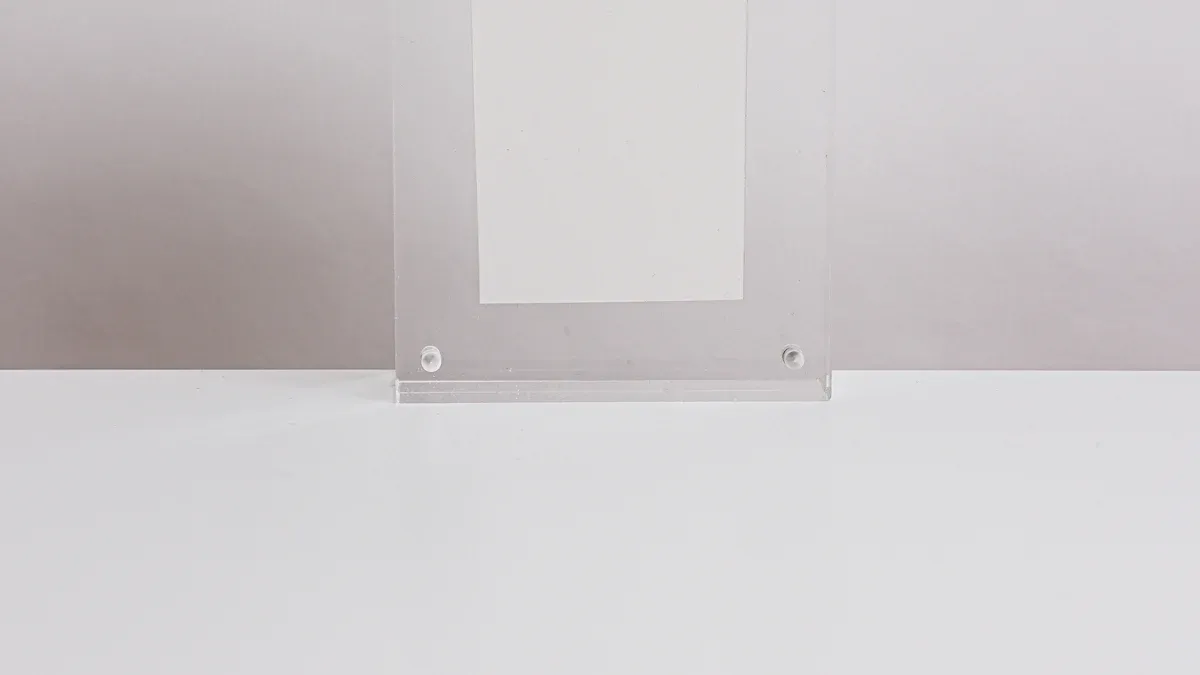How to Choose the Perfect Light Box Acrylic Panels for Your Display Projects

When you choose the perfect light box acrylic panels, your art looks amazing. The right panels spread light evenly, making displays bright and clear. For example, panels with a D/W ratio of 0.583 work best at a 50° angle for great brightness. Strong panels last longer, so you save time and money. Why choose less when the right panels can improve your art?
Key Takeaways
Pick clear acrylic panels for bright and sharp displays. Find panels that let light pass easily, like cast acrylic ones.
Think about strength when choosing panels. Tough acrylic lasts longer and saves money over time.
Choose the right thickness and size for your project. Thicker panels make displays brighter, and correct size fits your light box well.
Key Factors to Choose the Perfect Light Box Acrylic Panels

Transparency and Light Diffusion
For light box displays, transparency and light diffusion are important. Choose panels that let light pass through and spread evenly. Acrylic is better than glass because it lets in more light. It transmits light eight times better, making designs look clear and bright. Panels that are 20 mm thick and 30 cm long work well. These sizes help spread light evenly, making your display stand out. Whether for art or LED displays, the right panel makes your project look great.
Durability and Resistance to Wear
Durability is key if your light box is used often. Acrylic is strong and lightweight, making it last longer. Unlike some plastics, acrylic keeps its shape and strength. Tests like ASTM F732 check how well acrylic resists wear and tear. These tests show it works well indoors or outdoors. Strong panels save you money and effort over time.
Thickness and Size Options
The thickness and size of panels affect how they work. Panels 0.24 inches thick and 6.5 inches wide and long are common. These sizes balance strength and light spreading. Thicker panels make displays brighter and clearer. The right size fits perfectly in your frame. Measure your light box to pick the best panels for your design.
UV Protection and Weather Resistance
If your light box is outside, UV protection is a must. Panels with UV films block 99% of harmful UV rays. This keeps your display’s colors bright and clear. UV-resistant panels stay strong even in sunlight for a long time. They are great for outdoor or sunny areas. UV-protected panels keep your light box looking good and lasting longer.
Types of Acrylic Panels for Light Box Displays

Cast Acrylic Panels
Cast acrylic panels are great for light boxes. They are clear and strong. Liquid acrylic is poured into molds to make them. This process creates a dense and even material. Cast acrylic lets 92% of light pass through. It’s perfect for displays needing bright and clear visuals.
These panels last a long time. For example, ACRYLITE sheets won’t turn yellow for 30 years. They stay strong even with constant light exposure. Cast acrylic can handle heavy loads without breaking. If you want durable panels that stay good for years, choose cast acrylic.
Extruded Acrylic Panels
Extruded acrylic panels are cheaper and good for budgets. They are made by pushing melted acrylic through machines. This makes them less expensive than cast acrylic. While not as clear, they work well for many displays.
These panels have even thickness, making them easy to cut. You can shape them into custom sizes for your project. They are lightweight and affordable. Extruded acrylic is great for big displays or short-term projects.
Specialty Acrylic Panels (e.g., Frosted, Anti-Glare, or Colored)
Specialty acrylic panels have special features for displays. Frosted panels spread light softly for a nice glow. Anti-glare panels stop reflections, so displays stay clear in bright light. Colored panels add fun shades to match your design.
Here’s a quick look at specialty acrylic uses:
Type of Acrylic Sheeting | Features and Uses |
|---|---|
Solar Tinted Acrylic | Blocks UV rays and controls heat. |
Non-Glare Acrylic Sheeting | Stops glare and keeps items easy to see. |
Anti-Static Acrylic Sheeting | Stops static, good for electronics. |
Abrasion Resistant Acrylic Sheeting | Resists scratches, great for public areas. |
Impact Modified Acrylic | Strong like polycarbonate but clear and affordable. |
Lucite Block Acrylic Sheeting | Holds LED lights for smooth, glowing displays. |
Textured Acrylic Sheeting | Used for doors and partitions, adds privacy and strength. |
Specialty panels like frosted, anti-glare, or colored ones help your display stand out.
Practical Tips for Picking Acrylic Plastic for Your Display
Think About Your Project Needs
Before picking acrylic, know what your project needs. Are you making a light box for a gallery or home decor? Small displays under 12 inches work with 3mm acrylic. Bigger designs, like floor displays, need thicker panels. Use 6mm or more for panels and up to 12mm for shelves. The size and purpose of your display decide the acrylic type and thickness.
Also, think about how you’ll finish the edges. Flame polishing makes them shiny but can weaken the acrylic. Diamond polishing keeps edges clear and strong. Pick the finish that fits your design and lasts longer.
Plan Your Budget
Your budget matters when choosing acrylic. Extruded acrylic costs less and works for short-term projects. Cast acrylic is stronger and clearer but costs more. For top-quality displays, continuous cast acrylic is the best choice. Balance cost and quality to make your display look great without spending too much.
Find a Trustworthy Supplier
A good supplier is important. Research companies and check their experience with acrylic products. Look for certifications and reviews from customers. Compare prices, but avoid deals that seem too cheap. Reliable suppliers will communicate well and meet your needs.
Test Acrylic Panels Before Buying
Always test panels before buying them. Ask for samples to check their quality. Do tests like the reverse side impact test to see how strong they are. For outdoor displays, make sure the panels resist UV rays. Testing helps you pick the right acrylic for your project.
Tip: Try a strain test to see if the acrylic handles stress well. This ensures your light box stays strong for a long time.
Picking the right acrylic panels makes your light box stand out. You now know about important things like clarity, strength, and UV safety. You’ve also learned about types of acrylic and tips for choosing wisely. The right panels make your display look great and last longer.
Start by checking out suppliers or trying samples. Whether for art or business displays, the best acrylic panels improve your project. Don’t choose poorly—your work deserves the finest!
FAQ
Which acrylic panel is best for showing art?
Cast acrylic panels are great for art displays. They are clear and strong, making your designs bright and colorful.
Can acrylic panels handle outdoor weather?
Yes, UV-protected acrylic panels can handle sunlight and rain. They keep your display looking good even outside.
How can I test acrylic panels before buying them?
Ask for samples to check their clarity and strength. Make sure they block UV rays to fit your project needs.
See Also
Essential Advice for Choosing Acrylic Light Box Frames
Creating Stunning Displays with Acrylic Light Box Designs
Understanding Acrylic Light Boxes: Uses, Advantages, and Tips

